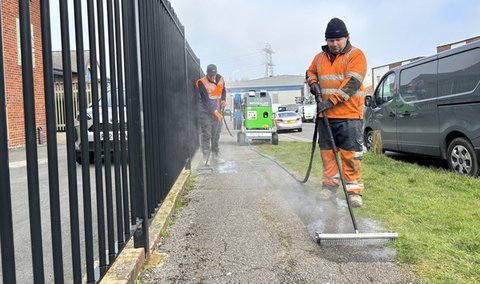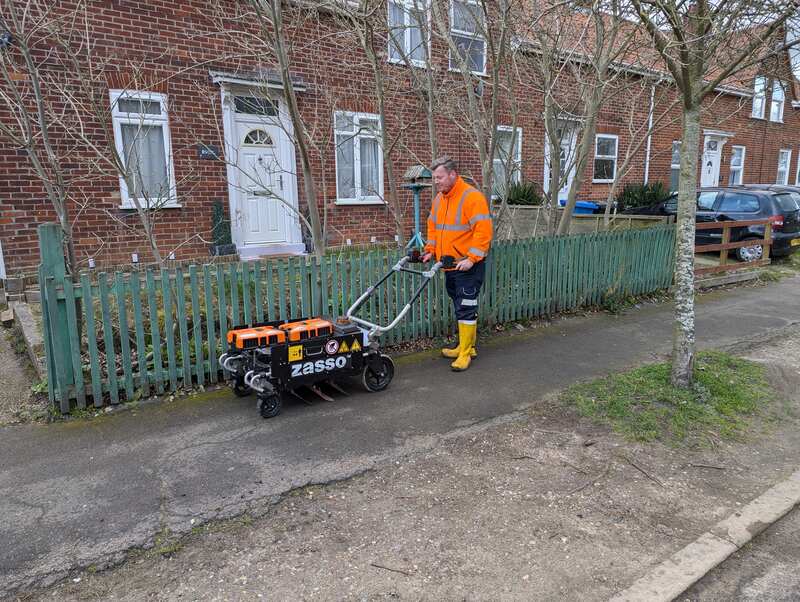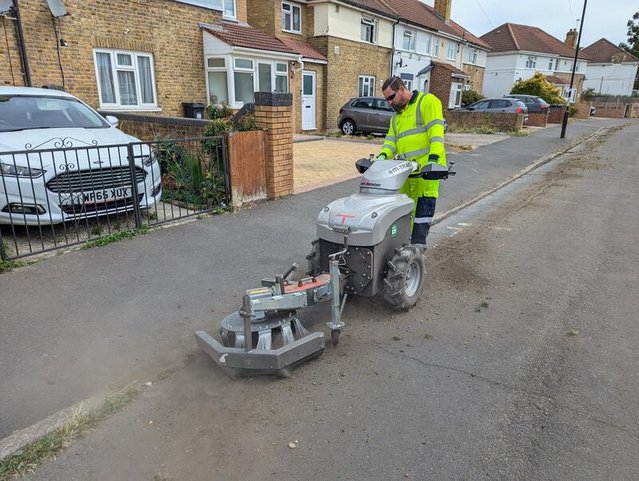Here's what we can learn from Europe about Weed Management
In Europe, they have had over a decade of trying pesticide free approaches, and many of their streets look cleaner than ours despite us still having access to pesticides. How can we learn from them?
Weeds on Our Streets? The UK is Missing the Lessons Europe Already Learned.
In continental Europe, countries like France, Belgium, the Netherlands and more recently Germany began banning pesticides in urban areas around a decade ago. In the UK, we're only now beginning this journey in pockets, and too often, local authorities act as if they are the first ones to ever face this challenge.
But we have an advantage that Europe never had: we have the benefit of a decade of their experience to learn from.
Ten years of product development and testing.
Ten years of understanding what works and why.
Ten years of understanding what doesn't work and why.
So here's a quick distillation of that learning.

The Common Pitfalls: What Definitely Doesn't Work
Before looking at the solution, it's vital to understand the failed approaches. These are the tempting "easy fixes" that inevitably lead to worse outcomes.
- Simply reducing pesticide use by going from 3 sprays to one or none.
- The Idea: "We'll just spray less by spraying less." It seems plausible.
- The Reality: A single spray clears the ground, creating bare soil. This is a perfect seedbed for a host of new, opportunistic weeds to colonise, creating a problem you then aren't treating. These weeds cause trip hazards and damage tarmac. Without a follow-up plan, you quickly lose control of your pavements.
- Replacing spraying with just manual labour.
- The Idea: "We don't want to invest in new equipment, so we'll use people." At first glance, this seems like a low-risk, low-capital solution.
- The Reality: You will struggle to recruit and keep staff. It is back-breaking, unrewarding work, and you will never stay on top of it without an enormous team. By the time you’ve employed enough people to handle the workload, the first ones you hired will have quit. You will ultimately spend far more on labour than you would have on equipment that makes the job more productive and ergonomic.
- Looking for one "magic wand" solution that fits everything.
- The Idea: "We need a single replacement for our chemical spray."
- The Reality: Even chemical pesticides aren't a true magic wand, and for the alternatives, an integrated approach is non-negotiable. If you don't combine weed treatment with proactive surface maintenance and prevention, you will be treating far more weeds than necessary, making any alternative seem slow and expensive.
The European Evolution: A Smarter Approach
Europe's success is built on three pillars: prevention first, a diverse toolkit, and investment in technology.
Over the past decade, a logical technological progression has emerged:
- The Foundation: Mechanical Cleaning. The first and most important step is removing the large accumulations of soil, detritus, and organic matter from pavement cracks and kerb edges. If there's no soil, there's nowhere for a weed to grow. They had several years where this was the primary method.
- The Control: Thermal Treatment (Hot Air/Water). Once the bulk of the soil is gone, thermal methods are incredibly effective at killing the remaining annual weeds and, over time, depleting the seed bank in what little soil is left. (Whilst still brushing, this method greatly enhanced the final results)
- The Specialist: Electro-thermal Weeding. More recently, electrical systems have proven highly effective for tackling the tough, broad-leaf perennials and invasive species that might survive the first two stages, such as Dandelions, giant hogweed and Japanese Knotweed.

The UK's Misdiagnosis: It's Not the Weeds, It's the Dirt
Right now, it looks to some like electricity is the new "magic bullet". The latest thing, that will kill what the others struggled with. My view is that it only looks that way because pioneering countries have already done the heavy lifting with years of soil removal and thermal treatments.
This is the critical lesson the UK is missing.
If you visit the Netherlands or Germany, you will find far cleaner streets than we have here, despite the long-term absence of pesticides. While many in the UK assume our weedy public spaces are a direct result of reducing spraying, the real issue is years of inadequate maintenance. The buildup of soil in pavement joints provides the perfect growing medium for weeds to thrive.
In the Netherlands and Germany, proactive and consistent street brushing isn't seen as an extra cost; it's the foundation of their entire weed management strategy. They solved the dirt problem first.
The Hamburg Model: Proving the Power of Strategic Patience
The lesson from Europe is clear: moving beyond chemical herbicides isn't about finding a simple substitute. It's an opportunity to completely upgrade our approach. But this upgrade requires a crucial ingredient: long-term political and financial commitment.
Look at the well-documented case of Hamburg, Germany, a city that began phasing out glyphosate over a decade ago. In the first few years, their costs went up. They had to invest in a new fleet of equipment for an integrated, two-pronged attack: intensive mechanical brushing and hot water treatment.
This initial phase was laborious. Crews had to tackle the legacy of weed seeds left in the soil, often requiring a combination of brushing and hot water treatments three to five times per season. Many would have given up at this point, declaring the project a costly failure.
But Hamburg's leaders held their nerve. They understood they weren't just treating weeds; they were fundamentally changing the environment. This combined strategy was key. The brushing physically removed the soil and detritus that weeds need to grow, while the hot water killed the remaining plants and cooked the legacy seeds in the pavement joints.
After three to four years of this intensive effort, the results were transformative. The seed bank in the soil was depleted, and the cleaner surfaces offered nowhere for new weeds to take hold.
Today, their maintenance program looks completely different. The most critical operational victory is that the required frequency of these combined treatments has dropped from a laborious 3-5 times per year down to just once or twice a year; the same as it was with chemicals.
Because they addressed the root cause (the soil) instead of just the symptom (the weed), their annual budget has stabilized. They have successfully pushed through the initial cost hump to reach a state that is not only better for the environment but is also operationally efficient and financially sustainable for the long term. This is the strategic patience the UK needs to adopt. We can't expect a decade-long problem to be solved in a single budget cycle.

The Ghent Model: Designing the Problem Away
If Hamburg shows us how to manage a problem, the city of Ghent in Belgium reveals the ultimate goal: how to eliminate it altogether. Their strategy focuses on prevention by design.
Whenever a street or square is renovated, they invest in weed-proof solutions: sealing pavement joints with solid mortars and planting robust groundcover in bare areas. This requires a higher upfront investment, but the payback is permanent. For every area they redesign, the annual cost for active weed control drops to virtually zero. Reports show this initial investment is often paid back within 3-7 years through the elimination of recurring maintenance costs.
However, this doesn't mean maintenance disappears. It simply changes its focus. The redesign prevents weeds from growing from below, but it doesn't stop leaves and dust from accumulating on top. Therefore, a regular, high-quality sweeping regime becomes even more critical to remove this new surface layer before it can become a seedbed.
This reinforces the central lesson from both cities: Control the soil, and you control the weeds.
Conclusion: We Can Skip the Mistakes
We don't need to reinvent the wheel, and we certainly don't need to repeat the costly mistakes. The roadmap has already been written for us.
By shifting our focus from a reactive cycle of "kill-regrow-kill" to a proactive strategy of "clean-prevent-treat," we can achieve better, longer-lasting results that are more sustainable for our environment, our budget, and our workforce. We have ten years of learning at our fingertips. It's time we started using it.
We don't even need to make the shift all at once. We can phase out the use of chemicals over a number of years, ensuring they are there if we need them in the meantime. It doesn't have to be a jump away; it can be a series of small, achievable steps.
No comments yet. Login to start a new discussion Start a new discussion